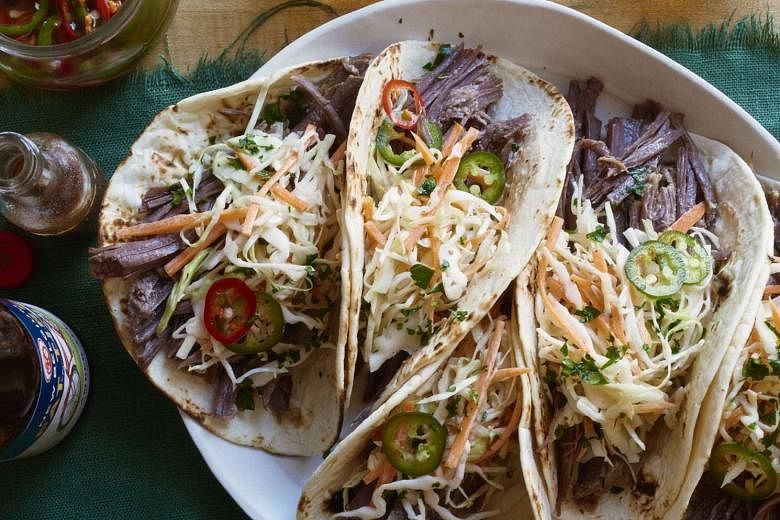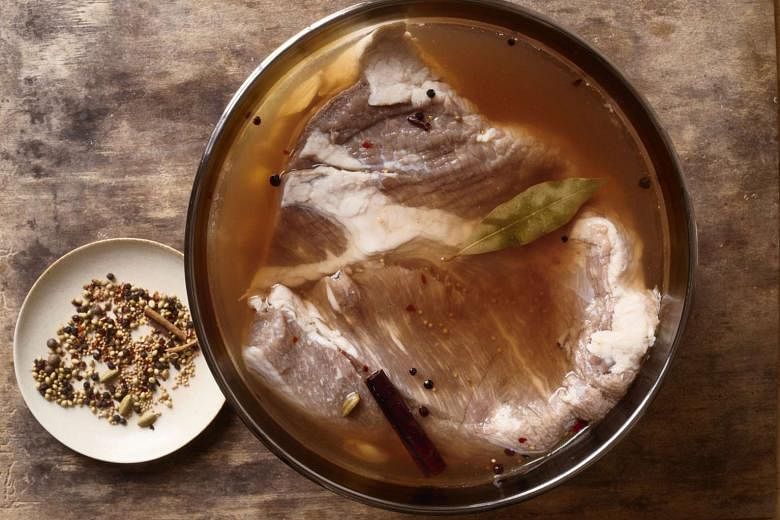NEW YORK (NYTimes) - Corned beef and cabbage is the scent of St Patrick's Day. A low, spicy pong of coriander and pepper, garlic and beef that carries a sweet, vegetal steaminess: the smell of low tide, ambrosia or a middle-school cafeteria, depending on your experience.
For a large number of Americans, particularly Irish-Americans and particularly at this time of year, as shamrock posters appear on cubicle walls, deli cases and in the windows of liquor stores, it is a smell that signals the arrival of spring and the celebration of a culture unique to America and practically unknown in Ireland itself.
"It's such a strong memory," said the chef Kerry Heffernan, who, among other activities, runs the seasonal Grand Banks restaurant aboard a schooner at Pier 25 in Manhattan. Heffernan grew up in Fairfield County, Connecticut, and remembers surreptitious train trips into New York this time of year to drink, underage, in the old Irish bars that used to dot Midtown, near Grand Central Terminal.
"You could smell the corned beef from the steam tables inside," he said. "We'd get smashed, eat a lot, and go home, tell people, 'We went to the city!' We went, what - a quarter block?" Celebrity chef and restaurateur Bobby Flay recalled similar youthful outings. He grew up in Manhattan and said it was a yearly tradition "to cut school on St Patrick's Day, go to the parade, then end up in a Blarney Stone with our fake IDs drinking beer and eating corned beef sandwiches on rye with lots of mustard". The corned beef was terrible, Flay said: "That smell!" It still is, too often: cheap cuts, cheaply preserved for a long life cycle.
-
Homemade Corned Beef
-
Ingredients
2 cups coarse kosher salt
½ cup sugar
5 garlic cloves, smashed
5 Tbs pickling spices
1 Tbs plus 1 tsp pink curing salt (sodium nitrite)
One 1.8 to 2.3kg piece of beef brisket
2 bottles of good beer
2 bottles of good ginger beer -
Method
1. Brine the brisket: In a medium pot set over high heat, combine about a gallon of water, the salt, the sugar, the garlic, 3Tbs pickling spices and the pink curing salt. Stir mixture as it heats until sugar and salt are dissolved, about 1 minute. Transfer liquid to a container large enough for the brine and the brisket, then refrigerate until liquid is cool.
2. Place brisket in the cooled liquid, and weigh the meat down with a plate so it is submerged. Cover container and place in the refrigerator for 5 to 7 days, turning every day or so.
3. To cook brisket, remove it from the brine and rinse under cool water. Place in a pot just large enough to hold it and cover with one of the beers and one of the ginger beers. If you need more liquid to cover the meat, add enough of the other beer, and the other ginger beer, to do so. Add remaining 2Tbs pickling spices. Bring to a boil over high heat, then turn heat to low so liquid is barely simmering. Cover and let cook until you can easily insert a fork into the meat, about 3 hours, adding water along the way if needed to cover the brisket.
4. Keep warm until serving, or let cool in the liquid and reheat when ready to eat, up to three or four days. Slice thinly and serve on sandwiches, in Irish tacos (see recipe) or with carrots and cabbage simmered until tender in the cooking liquid.
Total time: 3 hours, plus 5 days' brining
Yield: 8-12 servings
The chef Seamus Mullen got his first kitchen job in the cafeteria of his high school in northern Massachusetts in the early 1990s. He recalled the beef they used to make corned beef there. "It came out of a box labelled 'Grade D, edible,'" he said. "Oh, man." But, look: The heart wants what it wants. St Patrick's Day looms, and for some a real and abiding desire for corned beef comes along with it. Flay sometimes serves the dish for staff meals in his restaurants. Heffernan makes a corned salmon. Mullen, scarred by experience, does neither, although, he allowed, "It could be great." Exactly! What if you could make a great corned beef? What if you could make it taste the way it does not in the Irish pubs of memory but in the reality you sometimes see in the hot baths of Jewish delicatessens, where it sits aside pastrami, its smoked and spiced cousin: ruddy pink and salty and fatty and meltingly sweet?
You can do it easily, said Michael Ruhlman, a passionate advocate of the process and the author, with Brian Polcyn, of Charcuterie: The Craft of Salting, Smoking and Curing. You need only start by corning your own beef. "You can achieve tastes that aren't available in the mass-produced versions," he said. "Also, it's a genuine thrill to transform plain old beef into something so tangy and piquant and red and delicious." Corned beef takes its name from the salt that was originally used to brine it, the crystals so large they resembled kernels of corn. Curing and packing plants in Ireland used that salt in the 19th century to cure slabs of beef that went into barrels, later cans, and onto ships to feed, among others, British colonists, troops, slaves and labourers across the globe. Eventually someone in Boston or the Bahamas fished out a cut of beef neck or a brisket and boiled it into submission with a head of cabbage, and that was dinner.
We live in different times. The curing process may now lead you down long alleys of taste experimentation as you consider what pickling spices to use in your brine: coriander, mustard seed and black peppercorns, for sure, along with maybe allspice, ground ginger, bay leaves and cinnamon - or just a few tablespoons of a blend from a spice market or grocery you trust.
But it does require, Ruhlman suggested, that you go out of your way to find the curing salt that turns the meat pink: sodium nitrite. The substance was used originally to forestall the growth of bacteria. That may not be an issue for the refrigerated, modern age, he said, but it still delivers big, complicated flavour to home-corned beef.
It won't harm you, he added, for the benefit of those who fear nitrates and nitrites. He was vigorous on this point. Ruhlman's view: We already ingest a lot of nitrates in the form of vegetables that draw nitrogen from the soil. A few tablespoons of sodium nitrite added to a gallon of brine once or twice a year isn't going to cause anyone problems. "It's not a chemical additive," he said. "It's not red dye 40." Micah Wexler, the chef and an owner of Wexler's Deli in Los Angeles, agreed. "It's an unnecessary freakout," he said, to worry about curing salt. "Never mind the preservative power. That stuff adds an almost indescribable flavor. It's beefier than beef, more of itself. I don't like that 'umami' word, but it's there. You need it. It's not like you're sitting there eating the stuff with a spoon." So curing salt and pickling spices for the brine. Add a 3- or 4- or 5-pound (1.3 to 2.25kg) hunk of brisket to the solution, weigh it down and leave it in the fridge for five days or more. Corned beef requires forethought. It requires hardly any work.
Then when you are ready to cook, Wexler said, don't boil the meat. Don't get close to boiling it. Cook it at a bare simmer in liquid, or wrapped in foil in a low-temperature oven, "low and slow, for a really long time," he said. Use science, he added. "Get a probe thermometer and use it," he said. "We've found that if you want it on the tender, still sliceable end of the scale of doneness, well, that's an internal temperature between 185 and 190." If you're cooking in liquid, you can be a traditionalist and slide some cabbage and carrots into the liquid for the last hour of cooking - that is a boiled dinner in the New England tradition and a standard of the Irish-American canon, served with strong mustard. But you don't need to. I told Mullen that I make a bright cabbage slaw instead, and use it for tacos, wrapping the meat and vegetables in flour tortillas.
"Yes," he said, warming to the idea. "Not corn tortillas. That would be too fusion-y. I like it."
Irish Tacos
Total time: 30 minutes Yield: 6-8 servings
Ingredients
About 1kg of corned beef (see other recipe)
1 small head of green cabbage, cored and thinly sliced
3 carrots, peeled and julienned
1 cup mayonnaise
3 Tbs plain Greek yogurt or sour cream
3 Tbs cider vinegar Kosher salt and ground black pepper, to taste
1½ Tbs hot pepper sauce, or to taste
12 to 16 flour tortillas, warmed
Sliced fresh or pickled jalapeños
Method
1. Warm the corned beef in its cooking liquid, or wrap it in foil and set on a sheet pan in 170 deg. C oven for 20 minutes or so.
2. Make the coleslaw: Mix cabbage and carrots together in a large bowl.
3. In a separate bowl, whisk together mayonnaise, yogurt or sour cream, cider vinegar, salt, pepper and hot pepper sauce to taste.
4. Pour half the sauce over the cabbage and carrots and toss to coat thoroughly. Season to taste. Reserve remaining sauce.
5. When the corned beef is hot, remove from liquid or foil and use two forks to shred it. Serve with the warmed tortillas, sliced jalapeños, the slaw, remaining white sauce and some hot pepper sauce.



